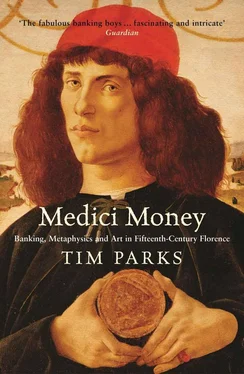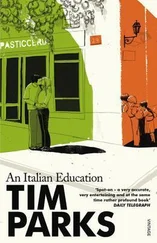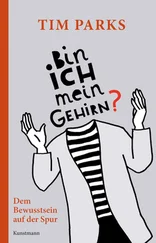The exchange rates are fixed daily, Sundays and holidays excluded, by paid bill brokers meeting together with merchants and bankers in the open street. In rainy Lombard Street in London. On the breezy Rialto in Venice. They don’t meet in anyone’s premises, since that would be an acknowledgment of that person’s supremacy. They consider trends in trade. They are aware of currencies whose coins are subject to a little trimming. Any member of the Exchangers’ Guild caught trimming his coins is liable to immediate expulsion! And the same goes for anyone passing on trimmed coins. Directly upon minting, the florin is sealed in leather bags, the so-called fiorino di suggello , or sealed florin. This to avoid trimming. But everybody knows that some people open the bags, replace the coins or trim them down, then reseal them. The florin is under observation. It is losing value against the Venetian ducat, and the Roman florin, not to mention Geneva’s golden mark. These experts know which mints are reducing or increasing the gold content, which currencies are silver based and which gold. Milan’s silver imperial just goes down and down. They know which governments are trying to intervene in the market, which way the speculators are moving. They get together daily and fix the rates as honestly as they can. Why, then, is the florin always worth about 4 pence more in Florence than it is in London?
Keep your eye on the ball. Our customer takes his 1,000 florins in Florence, where the florin is declared to be worth 40 English pence. The bill of exchange is written out at that rate. He instructs his agent in London to pay out in three months’ time. He does so. Our correspondent collects 40,000 pence (or £166 1s. 6d.). We, the bank, then instruct the correspondent to look for — and let us assume he finds — a local client, in London, wishing for a loan of the same amount and offering to pay it back in florins in, of course, three months’ time, the time it takes (officially!) to go from London to Florence. Perhaps he is a merchant buying a consignment of wool, speculating that when it arrives in Italy he can sell it for far more than what he paid for it in the Cotswolds.
So another bill of exchange is written out. But, even disregarding temporal fluctuations, the exchange rate is different in London. Here the pound is worth more. Here it will only take 36 pence to buy a florin. So the bill is written out at that exchange rate: Pay as is the custom £166 1s. 6d. (40,000 pence) in florins at a rate of 36 pence to the florin. And three months later, if all goes according to plan, we collect 40,000/36 = 1,111 florins. In six months we, the original lending bank, have made 11 percent, which is to say, an annual interest rate of 22 percent.
The Medici made hundreds of these deals. Basically, the trick is that the currency quoted as a unit is always worth a small percentage more in the country of issue. As far as Florence and northern Europe are concerned, the difference in the two exchange rates, which determines the banker’s profit, tends to be greatest in early spring, just before the Florentine galleys set out from Pisa for their long trip to Bruges. Because this is when demand for credit to finance trade is highest. It then narrows in the summertime. Manuals are written to help merchants and bankers get their minds around the system. Who needs interest rates?
But was it usury or wasn’t it? The theologians pondered. The bankers consulted them. No one wants to go to hell. Was it a loan with an interest rate, or was it an exchange deal? Remember, if currency rates changed drastically during the period of the transaction, then even the institutional difference between currency rates in different countries would not be enough to save the banker from a loss, or at least a very low profit. Conversely, the borrower could find himself paying a very high price for his loan if rates went further against him than they already were — if the pound, for example, rose vertiginously while those galleys were fighting their way up the Portuguese coast. As long as the geographical distance was maintained, the theologians decided, as long as there was a real exchange of currencies, as long as there was an element of risk, it wasn’t usury.
But to retain their credibility, the doctors of divinity cried a very loud foul at the so-called cambio secco , or dry exchange. In this kind of deal, when the bill of exchange became due in the foreign currency — say, sterling — the client did not pay up, but, after consulting the going currency rate, bought another bill for the exact amount owed. It is as if the first and second customers of the legitimate exchange described above, the man borrowing florins and the man borrowing pounds, were in fact the same person. This second bill then became due in the place where the first bill was issued — say, Florence — in florins, after the required period and at the new exchange rate. In this way, the period of the loan was doubled while the parties involved avoided actually using a foreign currency at all, although the element of speculation on rates, and hence of risk, was still there, since the exchange rates in London on the day in question were observed and a bill of exchange was written up. Hence, to be perfectly logical, there was no reason to say that this was any more or less usury than the regular bill of exchange. All the same, it was vigorously condemned by theologians because now it had become obvious that what the client really wanted was a loan, and not an exchange deal. Motivation is important. In 1429 the government of Florence banned the practice. It was clearly no more than a scam for usury. “To trade in licit exchanges.” Such was the declared purpose of the Medici bank. Yet it frequently dealt in “dry exchanges.” In 1435, when Cosimo took a dominant position in Florentine politics, the law forbidding such exchanges was swiftly revoked.
THIS THEN WAS the state of play: Usury was abominable but people needed loans and bankers a return for giving them. The complex system of differing exchange rates, possible only because of the time it took to travel from one financial center to another, provided an ambiguous territory that kept trade moving and many in a constant state of anxiety as to the destination of their eternal souls. Some merchants steered clear of the whole business, convinced it was a sin. Some less scrupulous operators were happy about the Church’s position because it scared off the squeamish and reduced the competition. The practical effect was that long-term loans became difficult, because a bill of exchange must always be paid in no more than the time officially required to reach one of the major European centers. Capital investment suffered. The bank became anchored to trade rather than manufacturing and was forced to become international, when otherwise it might well have stayed local. Loans were more expensive than they need have been, and highly speculative. “Exchange is a bird of passage,” warns one banking manual, “grab it while you can, it won’t be back!” Above all, there was constant tension between what people said they were doing, what they knew they were really doing, and what they knew they were supposed not to be doing. Meantime, every letter between banks on whatever matter always carried an avviso , a warning, or announcement, of currency rates on that day. Already information was of the essence. Stare sugli avvisi , to be on your guard, came to mean to deal in bills of exchange. On your guard! Such is the special excitement of dealing in money: am I winning or losing, am I going to heaven or hell?
One of the ways Giovanni di Bicci had always been on his guard was in his determination to have close relations with the Church, the ultimate source of capital: spiritual, political, and monetary. While in Rome, he had met the extrovert Neapolitan priest Baldassarre Cossa. Was it Giovanni di Bicci who funded the man’s purchase of a cardinal’s hat in 1402? It’s not clear. In any event, Cossa took to addressing the banker as “My most dear friend,” in his many letters.
Читать дальше












